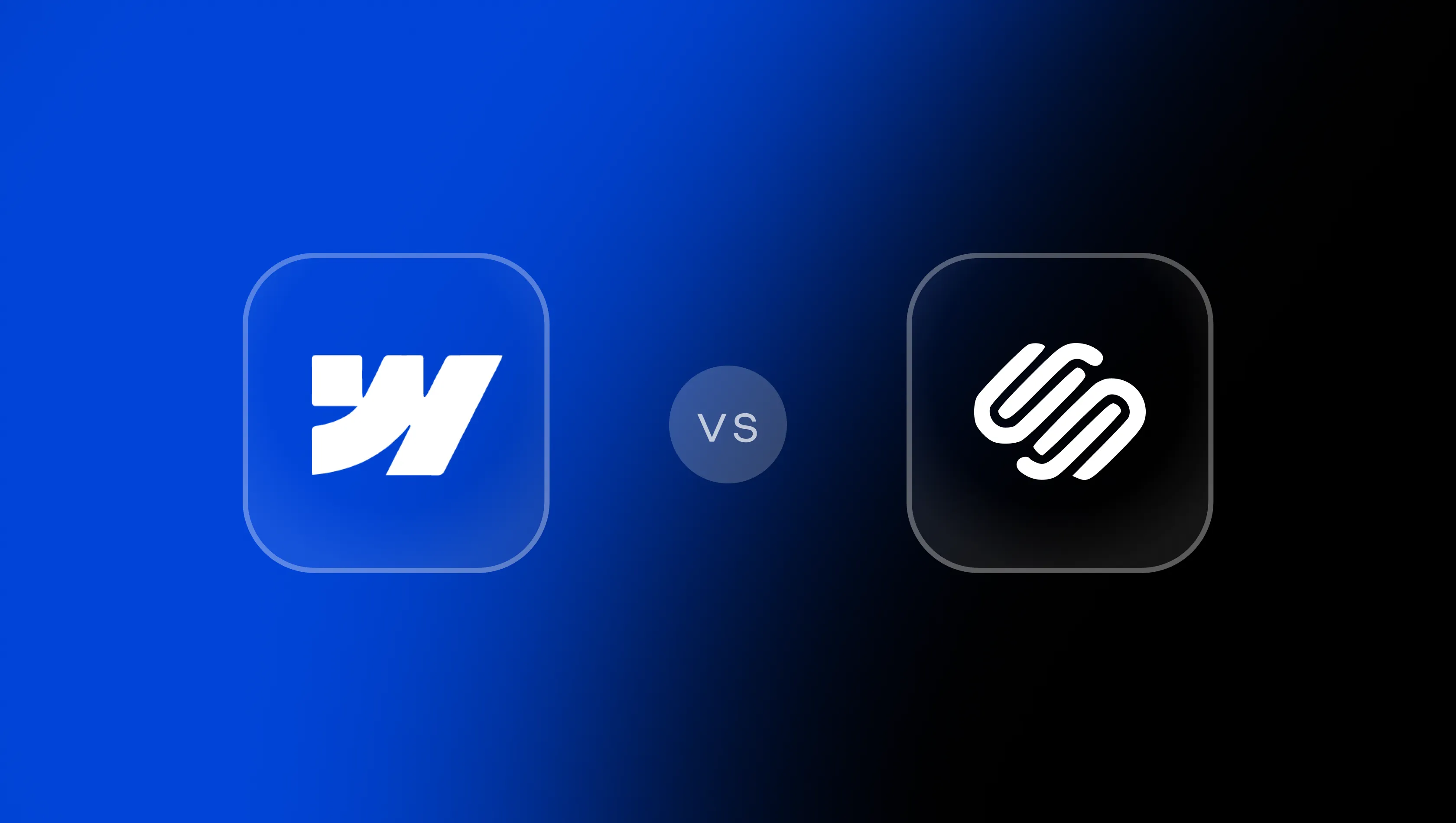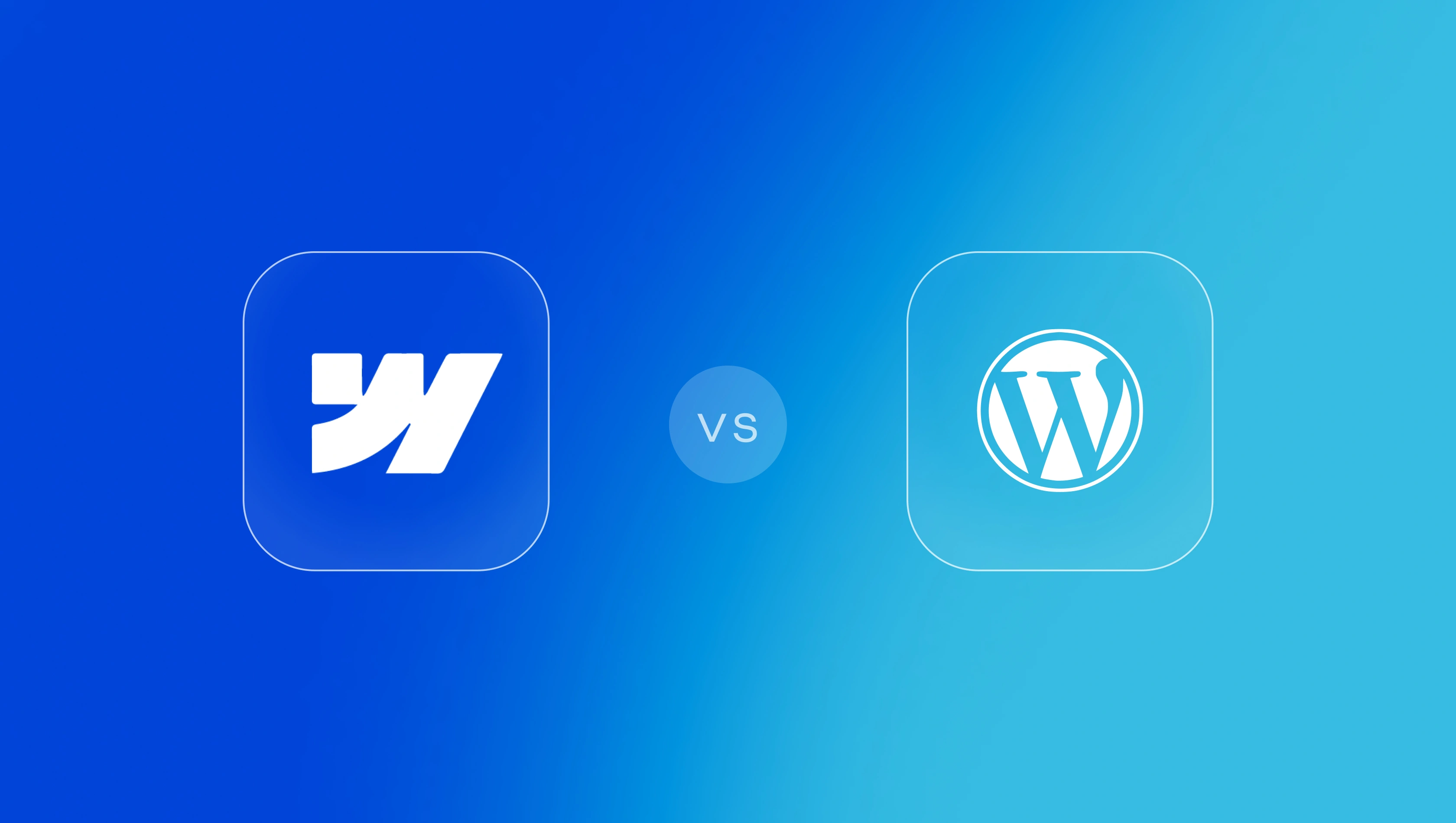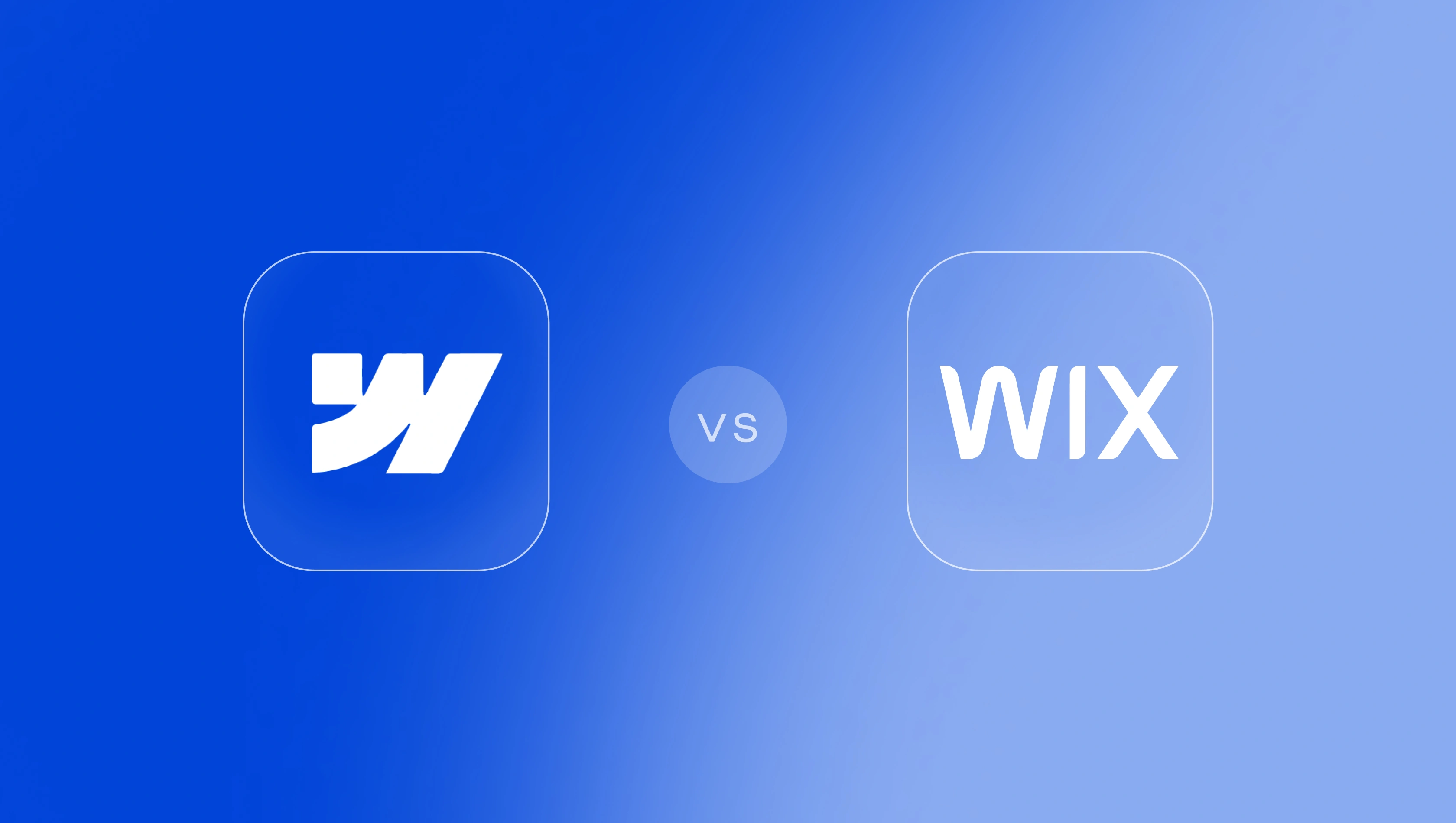Webflow vs. Squarespace: Which is Better?

The website builder you choose shapes how your business will approach web design, functionality, and long-term scalability. Two leading platforms, Webflow and Squarespace, offer powerful but very different approaches. Webflow provides design precision and development flexibility, while Squarespace focuses on simplicity, guided templates, and an all-in-one setup. This comparison explores how both platforms perform across design control, ecommerce, SEO, and ease of use to help you choose the better option for your next website design project.
What is Webflow?
Webflow combines design, development, and content management into one visual platform. It allows teams to build responsive websites visually while producing clean HTML, CSS, and JavaScript behind the scenes. Designers gain pixel-level control over layout, animations, and interactions, while editors can manage updates through the integrated Content Management System (CMS).
The platform supports custom code, content localisation, reusable components, and advanced ecommerce capabilities, making it ideal for businesses that need design flexibility, scalability, and performance without relying on plug-ins. For creative professionals, Webflow’s design tools offer the freedom to craft high-quality, bespoke websites that reflect brand identity precisely.
What is Squarespace?
Squarespace is an all-in-one website builder known for its polished templates and beginner-friendly experience. Users can design and launch a website quickly using a guided drag-and-drop editor with built-in hosting, security, and marketing tools.
It includes integrated ecommerce features, blog and portfolio options, and an intuitive dashboard that simplifies updates. Squarespace offers a strong visual foundation for small businesses and individuals who want a user-friendly, minimal platform. While it lacks the full creative freedom of Webflow, its consistency, reliability, and ease of use make it an accessible choice for those prioritising speed and simplicity.
Key Considerations
Design Flexibility
Webflow
Webflow gives full creative freedom through a visual no-code interface that mirrors HTML and CSS. Designers can customise layouts, animations, and responsive grids precisely. Every Webflow website stays clean and scalable, with reusable components, style systems, and adaptable Webflow templates. Ideal for teams prioritising design freedom, precision, and control, it enables fully bespoke results without restrictive templates.
Squarespace
Squarespace focuses on simplicity with elegant, structured templates. Its drag-and-drop editor lets users modify fonts, colours, and sections with ease, ensuring a cohesive visual style without technical setup. While perfect for beginners and small businesses, flexibility ends where template structure begins. Squarespace templates deliver consistent, polished design quality but cannot match Webflow’s design depth or creative range for advanced visual customisation.
Build Speed
Webflow
Webflow accelerates production through visual development and CMS-driven dynamic content. Global styles, components, and hosting automation reduce build time and manual tasks. Once familiar with Webflow’s no-code workflow, teams can prototype and publish quickly while maintaining precision. This efficiency supports faster launches and ongoing design optimisation for any Webflow site.
Squarespace
Squarespace streamlines setup for non-technical users. Prebuilt layouts, integrated hosting, and business plan features like analytics and scheduling make it fast to launch a site. The process is guided and linear, ideal for small businesses prioritising speed. While limited in flexibility, it remains one of the quickest paths to establishing an online presence.
SEO
Webflow
Webflow offers advanced SEO control for custom optimisation. Users can edit meta titles, descriptions, and 301 redirects, add schema, and adjust content at scale. Its clean structure and responsive performance boost search rankings, while the native option of localisation extends reach globally. For businesses that rely on organic traffic, a Webflow website delivers technical clarity and flexibility.
Squarespace
Squarespace covers fundamental SEO features for visibility but limits advanced configuration. It manages sitemaps and meta titles automatically, with simple on-page edits available to users. Although its structure supports solid optimisation, it lacks deep control over markup and schema. For broader visibility, Webflow offers greater precision, especially for high-growth or content-heavy sites.
Security & Maintenance
Webflow
Webflow manages security and updates automatically through AWS and Fastly CDN. Each Webflow website includes SSL, backups, and high uptime by default. Users focus on content while Webflow handles hosting and protection. With minimal maintenance and consistent performance, it delivers peace of mind for teams managing marketing sites or Webflow ecommerce.
Squarespace
Squarespace provides an all-in-one hosted environment with automated updates and SSL built into every basic plan. Users never manage patches or servers, reducing risks common in plug-in-based systems. Security is handled entirely by Squarespace, making it ideal for beginners who value simplicity and trust the platform’s controlled, maintenance-free infrastructure.
Ease of Use
Webflow
Webflow combines flexibility with a learning curve. Its interface mirrors design software yet offers full control over HTML and CSS for advanced no-code development. With the understanding provided by Webflow University, users manage layouts, content, and Webflow ecommerce efficiently. It suits professionals who want visual design power without traditional coding limits.
Squarespace
Squarespace is a beginner-friendly website builder. The visual editor, templates, and built-in guides make site creation intuitive from start to finish. The business plan unlocks deeper styling and ecommerce tools while remaining simple. Perfect for small businesses or freelancers wanting to maintain a professional online presence without needing technical knowledge.
Website Hosting
Webflow
Webflow hosting delivers speed and security through Amazon Web Services and Fastly CDN. Every plan includes SSL, backups, and fast content delivery. The system ensures consistent uptime and automatic optimisation. Sites scale easily with traffic and connect seamlessly to custom domains, ensuring reliable performance and growth for business-critical websites.
Squarespace
Squarespace hosting is built in across all plans. It includes SSL, and performance optimisation with zero setup. Users can purchase or connect a domain directly within the dashboard. Hosting quality is strong, stable, and effortless, providing dependable reliability for small businesses who want a managed, low-maintenance website builder.
Scalability & Future-Proofing
Webflow
Webflow grows with your brand through a powerful CMS that supports dynamic content and complex data relationships. You can effectively scale design systems, expand Webflow ecommerce, and integrate APIs. Its advanced features and regular updates ensure long-term adaptability, keeping each Webflow website future-ready for new tools and integrations.
Squarespace
Squarespace scales modestly within its closed system. It manages growth for ecommerce, blogs, and portfolios effectively but limits custom code or integrations. Updates add useful advanced features, yet flexibility remains capped. It suits stable business plans with predictable content needs but is less suited for complex or enterprise-level expansion.
Integrations
Webflow
Webflow integrates seamlessly with third-party systems and no-code tools like Zapier, Make, and HubSpot. Native embeds, custom code, and API access allow deep connections with CRMs, analytics, and email marketing platforms. For data-driven teams, Webflow offers unmatched flexibility to extend site functionality and optimise workflows across the entire online presence.
Squarespace
Squarespace integrates key tools directly within its ecosystem. Users can connect social media, payment providers, and marketing apps through its extensions marketplace. While dependable, integrations are limited to approved partners. Squarespace vs Webflow shows a clear difference here in that Webflow’s open approach enables more complex, scalable integrations.
Team Collaboration & Workflows
Webflow
Webflow enables seamless collaboration through Workspaces with clear role permissions for designers, developers, and marketing teams. Content editors now work directly in the Build environment using edit- and publish-level access, maintaining structure while updating CMS content. Shared projects, commenting, and version control streamline workflows, making Webflow an efficient, unified platform for scalable digital production.
Squarespace
Squarespace provides basic collaboration through contributor roles such as admin, editor, or store manager. Teams can update pages and content safely, though simultaneous editing is limited. While sufficient for small teams, it lacks Webflow’s multi-user sophistication. For streamlined agency collaboration, Webflow offers stronger workflow management and control.
Content Localisation
Webflow
Webflow includes native localisation tools for tailoring and translating content, SEO settings, and meta titles per region directly in the Designer. It supports locale-specific URLs, automatic hreflang tags, and regional redirects. For global teams, Webflow’s localisation delivers flexible, scalable, multi-language websites without third-party tools.
Squarespace
Squarespace supports multi-language sites through manual duplication or translation widgets. It lacks native hreflang and regional SEO controls. For brands expanding globally, Webflow offers a more efficient, scalable localisation system that simplifies updates and maintains consistency.
Customer Support
Webflow
Webflow provides email support, community forums, and Webflow University, offering tutorials for all skill levels. Paid plans receive faster responses. Its learning resources empower users to resolve issues independently and deepen platform expertise.
Squarespace
Squarespace delivers 24/7 live chat and email support. A detailed help centre covers templates, ecommerce, and setup. It’s ideal for beginners needing quick, guided help, though less technical than Webflow’s documentation.
Pricing
Webflow
Webflow pricing separates Site plans and Workspace plans. The free starter allows testing, while CMS, business and ecommerce plans scale with features, traffic, and online sales needs. Webflow offers flexible options for agencies but may cost more as a platform than basic builders.
Squarespace
Squarespace pricing is clear and all-in-one, with Personal, Business, Basic, and Advanced Commerce tiers. The basic plan suits small sites, while higher tiers add ecommerce tools and lower transaction fees. There is no permanent free plan, just a trial.
Enterprise Solutions
Webflow
Webflow Enterprise provides advanced features for large teams, including SSO, audit logs, custom integrations, page branching and dedicated support. Enterprise clients gain governance tools, localisation, and performance optimisation at scale. Its infrastructure supports reliability and control across thousands of pages, making it ideal for global brands seeking a secure, flexible platform.
Squarespace
Squarespace focuses on individuals and small businesses. Its Advanced Commerce plan adds promotional and analytics tools but lacks enterprise-level governance or technical depth. While dependable for growing ecommerce sites, it cannot match Webflow Enterprise for scalability, compliance, or advanced features. It best suits established brands with straightforward online needs.
Webflow: Pros & Cons
Pros
Unmatched Design Freedom
Webflow gives complete creative control through its visual designer, enabling unique website design without templates or coding restrictions. Perfect for bespoke, high-quality digital experiences.
Clean, Semantic Code
Automatically generates optimised HTML, CSS, and JavaScript for strong SEO, performance, and accessibility. Code quality rivals hand-built websites, ensuring speed and long-term maintainability.
Robust CMS
The flexible Content Management System supports dynamic, structured content for blogs, portfolios, and ecommerce, streamlining large or frequently updated sites.
Advanced Animations and Interactions
Design complex animations and interactions natively for polished, engaging websites that stand apart from static templates.
Native Localisation
Localisation tools allow region-specific content, SEO, and URLs within the Designer, supporting multi-language websites without third-party plugins.
Collaboration and Workspaces
Role-based access, version control, and shared workspace features simplify teamwork across designers, editors, and developers.
Strong SEO Control
Granular SEO settings, custom redirects, and schema markup support precise optimisation and improved rankings.
Scalable Hosting
Hosted on AWS and Fastly CDN for reliable performance and high traffic capacity.
Cons
Steep Learning Curve
Beginners may find the interface complex, requiring time to learn Webflow’s design and layout structure.
Higher Cost for Advanced Plans
Webflow pricing increases with add-ons like localisation or use of Webflow’s ecommerce platform, meaning it can cost more than simpler website builders.
Limited Plug-in Ecosystem
Fewer one-click extensions compared with competitors such as WordPress or Wix, requiring custom code for some features when there isn’t a native app yet.
Requires Design Knowledge
Effective use depends on understanding the box model, responsive design and layout principles.
E-commerce Depth
Solid for small to medium stores but lacks some advanced ecommerce features of platforms like Shopify.
Squarespace: Pros & Cons
Pros
Exceptional Ease of Use
Squarespace is a beginner-friendly website builder with an intuitive drag-and-drop editor that simplifies every step of creating and managing a site.
Polished Templates
Offers a curated range of visually refined Squarespace templates that ensure professional presentation across all devices without requiring design experience.
All-in-One Platform
Combines hosting, SSL, SEO tools, and ecommerce features into one unified system, reducing the need for external plug-ins or third-party management.
Integrated E-commerce
Supports secure online stores with inventory, shipping, and checkout tools, ideal for small businesses and entrepreneurs.
Built-in Marketing Tools
Includes email campaigns, social media integrations, and analytics for consistent promotion and brand visibility.
Reliable Customer Support
Provides 24/7 live chat and email assistance, backed by comprehensive tutorials for beginners and experienced users alike.
Cons
Limited Design Flexibility
Design is restricted by each template’s framework. Custom CSS or HTML changes are possible but limited compared with Webflow’s design freedom.
Basic SEO Control
Includes essential SEO features but lacks advanced options such as schema editing or structured data management.
Closed Ecosystem
Limited access to custom code and fewer third-party integrations than open platforms.
No Free Plan
Only offers a short free trial, with all active sites requiring a paid pricing plan.
Scalability Constraints
While excellent for small businesses, the platform is not built for complex or enterprise-level projects requiring advanced control or functionality.
Webflow vs Squarespace Summary
Webflow and Squarespace both deliver powerful tools for building professional websites, but they cater to different priorities. Squarespace focuses on accessibility, guided templates, and simplicity, ideal for beginners or small businesses wanting quick, polished results through simplified website building. Webflow, on the other hand, is built for designers and teams seeking full creative control, custom code flexibility, advanced SEO and extended capabilities for growth.
For long-term scalability, localisation, and technical precision, Webflow offers a more adaptable solution that grows with your business. Squarespace remains a strong option for those who prefer an all-in-one website builder without the learning curve.
At Edition, we use Webflow to craft high-performing, visually refined digital experiences that combine design freedom with measurable results. Whether creating localised marketing sites, or highly dynamic CMS builds, Webflow provides the precision and scalability modern brands require—let’s talk.
FAQs
What makes Webflow a professional website builder?
Webflow is a flexible website builder that brings design and development together in one visual platform. It generates clean HTML, CSS, and JavaScript, ensuring performance and scalability. Teams can create custom layouts, manage dynamic content, and optimise SEO directly within the interface. Unlike template-based tools, Webflow supports complete creative freedom, letting brands maintain design precision, faster publishing, and stronger technical reliability across projects.
Is Squarespace easier to use than Webflow?
Squarespace is simpler to learn, offering guided templates and an intuitive drag-and-drop experience that appeals to beginners and smaller teams. Sites can be built quickly without any technical setup. Webflow involves a steeper learning curve but provides far greater design flexibility and long-term scalability. For brands that require precise control and custom functionality, Webflow’s structured visual environment is better suited to professional workflows.
Which platform performs better for SEO?
Both platforms include core SEO tools, but Webflow gives greater technical control. You can customise meta titles, descriptions, and URLs, manage sitemaps, and edit markup directly. This structure supports faster loading and stronger rankings in search engines. Squarespace offers essential SEO features, yet its automation can limit detailed optimisation. For businesses prioritising visibility and adaptability, Webflow offers more advanced search management.
Can both platforms support ecommerce?
Both Webflow and Squarespace provide ecommerce features, but they focus on different users. Squarespace offers a simple, integrated approach that suits small businesses selling limited products. Webflow enables full design freedom for storefronts, allowing detailed control over layout, branding, and checkout flow. It integrates with marketing tools and supports custom ecommerce plans for growing brands. While Shopify remains stronger for enterprise retail, Webflow delivers a more design-led ecommerce experience.
How do pricing plans compare?
Squarespace pricing is straightforward and includes hosting, SSL, and built-in ecommerce in a single monthly cost. Webflow’s pricing scales by project scope, offering site plans, workspace tiers, and optional localisation. Although its higher tiers cost more, they provide flexibility and control suited to professional builds. For teams managing growth or multiple campaigns, Webflow offers better scalability and structural depth than all-in-one alternatives.
Which is better for long-term growth?
Webflow supports growth with a powerful CMS, reusable design components, and integration with third-party systems. Its custom code capabilities and scalability make it a strong foundation for expanding websites and content strategies. Squarespace offers ease and reliability for smaller projects but limits structural evolution over time. For brands planning future development or larger-scale digital ecosystems, Webflow provides the adaptability required to support ongoing growth.




